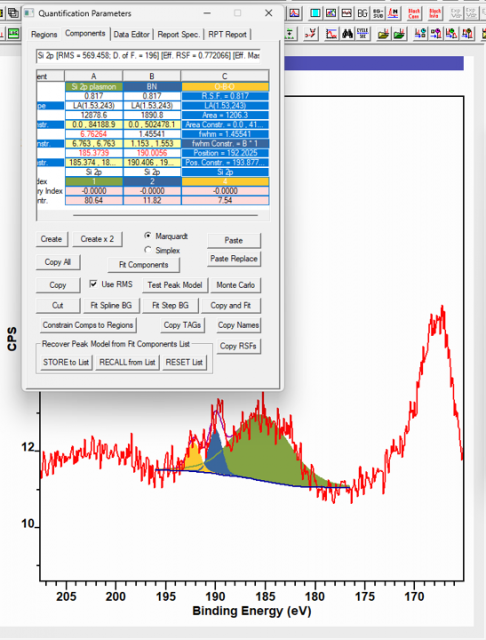
Boron
Doublet Separations
- B 1s only practical emission
- While B 2p does appear in the valence region, it is practically not useful, and the spin-orbit splitting value is not widely reported
The Energies Listed are Binding Energies!
B 1s: 188 eV
The Energies Listed are Binding Energies!
Overlaps for B 1s (primary emission)
- Br 3d (182 eV)
- Zr 3d (183 eV)
- Po 4f (184 eV)
- Yb 4d (184 eV)
- I 4s (186 eV)
- P 2s (189 eV)
- La 4p (192 eV)
- Si 2s (see experimental advice for more details)
Energies listed are Kinetic Energies!
B KLL: ~ 170 eV
The Energies Listed are Binding Energies!
| Species | Binding energy / eV | Charge Ref | Ref |
| B | 187.7 | Graphitic Carbon (284.6 eV) | 1 |
| B-C | 188.7-189.3 | Graphitic Carbon (284.6 eV) | 1, 2 |
| B4C | 188.2 | Graphitic Carbon (284.6 eV) | 1 |
| B-O | 190.2 | Graphitic Carbon (284.6 eV) | 1 |
| O-B-O | 192 | Graphitic Carbon (284.6 eV) | 1 |
| B-N | 190.8 | Graphitic Carbon (284.6 eV) | 3 |
| B2O3 | 193.5 | Graphitic Carbon (284.6 eV) | 1 |
Boron has a remarkably low signal in XPS, due to the very low photoionisation cross section(4) of the 1s orbital (the only accessible orbital by XPS).

Photoionisation cross sections taken from Anna Regoutz website (5), a tabulation of values from the work of Schofield (reference 4).
Boron 1s overlaps with plasmon features from Si 2s, which may make things tricky if you are trying to detect B in Si.

It is helpful to record an extended region, in order to capture both the Si 2p and 2s, and model out the plasmons / loss features in the case of low boron content, and extract the buried B 1s peaks.

It is likely that many scans will be required to obtain good statistics for the B 1s signal, unless it is available in large quantities.
It is good practice to record a short spectral signal before and after a long scan time, in order to determine any analysis induced changes to the sample during measurement. Boron does have the potential to undergo sample damage (particularly in the form of SAMs), and so ensuring the sample signal remains consistent is critical.

B on Si (plasmon overlap) is a great example of where constraints in CasaXPS (and other softwares) come in really handy. For example, in the dataset above we have 2 BN solutions deposited onto SiOx/Si wafer. By first modelling the SI plasmon alone (pre-deposition), we can lock the parameters so that when we add B 1s peaks, we keep the same peak shape for our plasmon loss.

Now, once we have added a peak, using the ‘#’ key, followed by a value (e.g. 0.1) in the ‘FWHM constraint‘ or ‘position constraint’ box, allows Casa to set upper and lower limits for FWHM and position when fitting (by a value of whatever number follows the # key.
Then, if we copy this model to our unknown sample, and add in new peaks (for Boron), we will not perturb the Si 2s plasmon loss.

We can also apply this to our smaller features in the second example set, where fitting the peaks may be even trickier.

For more information on using peak constraints, see the video below:
You can follow the example given in the fitting advice section and try and process the B 1s / Si 2s plasmon overlap in CasaXPS.
- Ennaceur, M. M., and B. Terreault. “XPS study of the process of oxygen gettering by thin films of PACVD boron.” Journal of nuclear materials 280.1 (2000): 33-38. Read it online here.
- Jacobsohn, L. G., et al. “X-ray photoelectron spectroscopy investigation of boron carbide films deposited by sputtering.” Surface Science 572.2-3 (2004): 418-424. Read it online here.
- Deng, Jinxiang, and Guanghua Chen. “Surface properties of cubic boron nitride thin films.” applied surface science 252.22 (2006): 7766-7770. Read it online here.
- Scofield, James H. Theoretical photoionization cross sections from 1 to 1500 keV. No. UCRL-51326. California Univ., Livermore. Lawrence Livermore Lab., 1973. Read it online here.
- Anna Regoutz, Applied X-ray Spectroscopy, https://a-x-s.org/research/cross-sections/, accessed 19/09/2024